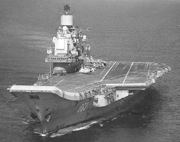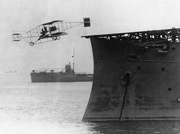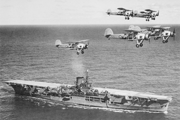E-Archive
Off the Beaten Track
in Vol. 12 - November Issue - Year 2011
Like Flying off a Cliff!

A modern aircraft carrier with a ski-jump ramp

Eugene Ely taking off in November 1910

HMS Ark Royal
The young man’s hands were damp with perspiration as he gripped the control stick on his stationary airplane. He studied the flat surface in front of him as he listened carefully to make sure that the engine was turning over smoothly. Twenty-five meters! He had only twenty-five meters in which to take off with his Curtiss pusher biplane and clear the edge of the platform, under which the blue waters of the Atlantic Ocean shimmered in the morning sunlight. Taking a deep breath, he pushed the throttle as far as it would go and the plane lurched slowly forward. His heart missed a beat as the aircraft plunged downward upon clearing the improvised runway. Would he make it? Its wheels skimmed the surface of the water, but a moment later, the plane was rising higher and higher in the air. Success!
*****
Kites and hot air balloons were the first airborne structures to be launched from ships for military operations. In 1806, kites were used by a British Royal Navy warship to drop anti-Napoleon propaganda on French coastal cities and in 1849, manned hot air balloons were launched from Austrian warships for the purpose of dropping bombs on the enemy. For many years, balloons tethered to ships were used for observing enemy lines or for helping artillery units to spot targets on the ground.
The basic design of aircraft carriers was developed in the early 1900’s, along with the development of fixed-wing and engine-powered aircraft, although the earliest structures were not recognizable as aircraft carriers as we know them nowadays. In 1911, the French were the first to develop a warship that could carry seaplanes on deck and lower them to the sea with cranes. They were imitated by the British Royal Navy two years later. In the Far East and in Europe during World War I, successful attacks were carried out by Japanese and British seaplanes that had been transported to the front by carrier ships equipped with cranes. Armed forces around the world took notice of these successes and began experimenting with different ship designs.
The main limitation of the crane system was that it was too time-consuming, as planes had to be lowered or lifted from the sea one by one with a cumbersome and sometimes dangerous procedure. In 1909, the French inventor Clément Ader published a book in which he described a ship with a flat flight deck and elevators to park airplanes safely below deck. His ideas were taken up by the U.S. Navy, which fitted a wooden platform over the forecastle of the armored cruise ship USS Birmingham. It was from this platform that a young man named Eugene Ely became the first aviator to take off from a ship in November 1910. Two months later, he also became the first pilot to land an airplane on a ship, using for the first time a tail hook to slow down his plane with a rudimentary system of ropes tied to sandbags.
After these successful experiments, development of flat-deck carriers began in earnest and in the years 1914 and 1918 the British Royal Navy launched the world’s first flat deck and full-length flat deck aircraft carriers, the HMS Ark Royal and the HMS Argus, the latter remaining in active duty until 1944.
Since that time, aircraft carriers have come a long way, going from the relatively small 14,500 ton ships at the beginning of last century to the over 100,000-ton behemoths sailing the seas today.
By Giovanni Gregorat, Contributing Editor MFN & Sales Manager, Pometon Abrasives
Author: Giovanni Gregorat



























